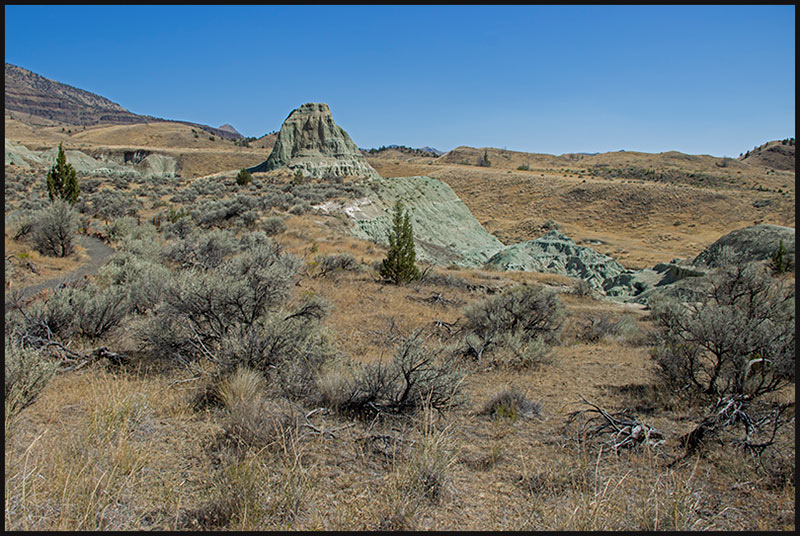El mapa de las principales zonas visitadas, junto con la lista completa de especies de aves observadas durante este viaje, puede encontrarse en este enlace.
The map showing the main visited locations, together with the complete list of bird species observed in this trip, can be seen in this link.
6. Sisters.
Tras la visita a la costa nos adentramos hacia el interior del estado. Paramos a visitar el bonito pueblo de Sisters, que mantiene un aire a antiguo pueblo del oeste. Abundaban las tiendas y restaurantes y, sin duda, merece la pena hacer una parada.
After the visit to the coast we went to the inner part of the state. We first stopped to visit the pretty town of Sisters, which is well maintained as an old western town. Shops and restaurants abounded and definitely worth a stop.
7. Smith Rock State Park.
Para mi, una de los sitios más interesantes que visitamos. Las vistas eran magníficas, y además pudimos disfrutar de 18 especies de aves, entre las que se incluyeron colines de california, vencejos gorjiblancos, águila pescadora, y cucarachero roquero. Entre los mamíferos, un buen número de ciervo mulo y, además, observamos una letrina de nutria. Al acabar la visita nos alojamos en Prineville.
For me, one of the most interesting places we visited. The views were magnificent, and we were also able to enjoy 18 species of birds, including california quails, white-throated swifts, osprey, and american rock wren. Among the mammals, a good number of mule deer and, in addition, we observed an otter latrine. After the visit we went to Prineville, where he had rented a room.
Park map and trails done (in red)
8. John Day Fossil Beds National Monument: Painted Hills Area.
Desde Prineville visitamos, al día siguiente, el John Day Fossil Beds National Monument. Las coloridas formaciones rocosas que es posible observar en la zona conservan un registro de la evolución de plantas y animales, junto con los cambios climáticos y los ecosistemas que existieron en los últimos 40 millones de años. El monumento se divide en varias áreas (ver el enlace para las áreas y sus caminos), cada una con sus características peculiares. La Painted Hills Area es sin duda la más interesante, por los increibles colores que forman las colinas. No es una zona que destaque por su avifauna, aunque pudimos ver algunos alcaudones americanos y varios cucaracheros roqueros.
From Prineville we visited, the next day, the John Day Fossil Beds National Monument. The colorful rock formations that can be seen in the area keep a record of the evolution of plants and animals, along with climate changes and ecosystems that existed in the last 40 million years. The monument is divided into several areas, each with its own peculiar characteristics (follow the link for information on each area and the corresponding trails). The Painted Hills Area is undoubtedly the most interesting, due to the incredible colors that form the hills. It is not an area that stands out for its birdlife, although we were able to see some American shrikes and several rock wrens.
9. John Day Fossil Beds National Monument: Foree Area.
Foree Area and Sheep Rock Unit map
En la Foree Area lo más interesante fueron unos chingolos arlequines, además, por supuesto, de los paisajes.
In the Foree Area the most interesting were some lark sparrows, besides, of course, the landscapes.
10. John Day Fossil Beds National Monument: Sheep Rock Unit-James Cant Ranch Historic District.
Para acabar la visita al John Day Fossil Beds National Monument, nos acercamos al James Cant Ranch Historical Distric, donde está la oficina de información y el museo. El paisaje aquí era diferente, con más verdor, y permite visitar un antiguo rancho. Nuevamente pocas especies de aves, pero la visita merece la pena.
To end the visit to the John Day Fossil Beds National Monument, we went to the James Cant Ranch Historical District, where the information office and the museum are located. The landscape here was different, with more greenery, and allows you to visit an old ranch. Once again few species of birds, but the visit is worth it.
11. Mitchell.
En esta zona comimos en Mitchell, un pequeño pueblo del oeste, que mantiene la esencia de lo que fue una vez. Y volviendo hacia Prineville, nos sorprendió un coyote.
In this area we had lunch in Mitchell, a small western town that maintains the essence of what it was once. And while coming back to Prineville, a coyote surprised us.
12. Prineville.
Finalmente, al atardecer pude aprovechar para pajarear un poco alrededor de nuestro alojamiento. Concretamente me acerque al Gervais Park, donde hay un pequeño riachuelo frente a un campo de golf. Aquí pude ver un buen paso de añapero yanqui, un vencejo de Vaux, varios chingolos cantor, y varios zanates de Brewer.
Finally, before sunset I had the opportunity to do some birding around our accommodation. I went to near Gervais Park, where there is a small stream in front of a golf course. Here I was able to see a good passage of common nighthawk, a Vaux's swift, several song sparrows, Brewer's blackbirds.








































